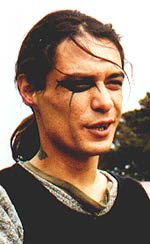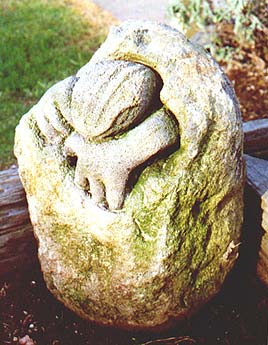BAFA © 2010. All material here is copyrighted. See conditions above. |
Reece Rongonui,
sculptor, Aotearoa / New Zealand.
|
 |
Iíve been carving stone for the last 4 years and I started doing this intuitively when I was in the bush for a time. I made an axe and just starting carving with river stone I found and it just has gone on from there. I start with just playing with the form of a rock or stone adn then ideas or shapes come from that. I like the idea of changing something that seems impossible or hard to change such as rock, and this reflects my attitude to life. That we can always change and nothing is impossible.
My first stone I sold, carved in river stone (much harder than marble) was finished in a day. Generally I carve in volcanic stone which is common here in Taranaki and it is very hard and brittle to work with. Currently I am based in rural Taranaki in an old factory and I usually work when it is warm enough to work outside.
|

I use hand tools about 80% of the time and diamond cutters the rest of the time. I tend to sell my work at stone carving symposia and only need to sell a few big pieces a year in order to have enough to live from. My goal is to pay the mortgage!
There is a national symposium in a different part of the country each year to which 20 to 30 New Zealand-based sculptors are invited along with about 10 international sculptors. I not only sell my work here but also have a chance to see what other stone carvers are doing. I donít sell my work through galleries. My carving is more about day-to-day survival than the art world. Generally my work sells immediately and this gives me the freedom to be more selective about what I do. On the other hand because I work very fast people think they can get them cheaply. For example a recent sculpture which took half a day to carve sold for $5000.
Yet, carving is a life-time thing and something of the spirit, not something you can pay for by the hour.
|
I have three life-size carved heads in Venezeula where two of these are in remote villages. Sometimes my work goes to museums and sometimes to rural areas. For example, one piece was bought by the Te Papa museum (New Zealand National Museum) as a guardian stone for any future remains of Maori bodies. Previously Iíd traded some of my sculpture with a few American museums to get some preserved Maori tattooed heads back to our people.
|

Mermaid sculpture in progress, 2000
New Zealand.
|
One commission I did was to carve portraits of the 19th century Taranaki Maori leaders, Te Whiti and Ua for two Maori Tribes. Gandhi was inspired by their use of pacificist resistence to their land being stolen by the British...
Iíve also done a number of headstone carvings for the ancestors of Maori people and so my work has served as a mouthpiece for others as much as for myself. I have just been invited to participate in a sculpture symposium in Korea in early 2001 and you can view some of my work at: http://virtual.tart.co.nz
Excepts from page 9, Arts Dialogue, February 2001.
|

Arts Dialogue, Dintel 20, NL 7333 MC, Apeldoorn, The Netherlands
email: bafa@bahai-library.com
|
|


